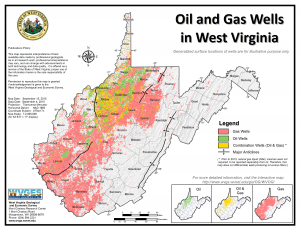From an Article by Jane R. Eggleston, West Virginia Geology, Updated in September 1996
Long before the arrival of European settlers, it is believed that the Native Americans recognized and perhaps used as a fuel source the “burning springs” and outflows of petroleum on the Little Kanawha, Kanawha, and Big Sandy rivers. Records show that the early settlers were also aware of the “burning springs” which were natural gas vents. One such burning spring, located on the Kanawha River, was visited by George Washington in 1775.
The oil and gas industry in West Virginia actually began as an outgrowth of the salt industry. In the early 1800s, oil and gas had no importance in West Virginia, and though saltmakers frequently hit oil or gas in their drilling, they considered it a nuisance. In fact, so much oil was diverted to the Kanawha River by salt manufactures that it was long known as “Old Greasy” to the boatmen. Gas was first struck in a well drilled for salt at Charleston in 1815. Once the value of oil and gas was realized, the Great Kanawha Valley region became a pioneer in the discovery of petroleum by boring and in the use of oil and gas on a commercial scale. By 1826, oil was used for lamps in workshops and factories. The drilling tools, jars, and casing, first developed in 1806 by the Ruffner brothers for the salt industry, became essential equipment to the petroleum industry of the United States.
On the Little Kanawha River, near the Hughes River, was a stream called Burning Springs Run, named because there were two springs at its mouth from which natural gas escaped. As early as 1781, Thomas Jefferson described the brilliant flame which could be produced by thrusting a lighted candle into the escaping gas at this site. Because gas and salt brine were often associated, the Rathbone brothers bored a salt well near these springs. However, rather than salt, at a depth of 200 feet they hit petroleum and by boring deeper, they were able to produce 200 barrels per day in 1859. Although petroleum was not the treasure that the Rathbones sought, they were encouraged by their find and drilled a second well which yielded 1,200 barrels of petroleum daily. News of the Rathbone brothers’ discovery spread rapidly and created tremendous excitement. By 1861, a town with several thousand inhabitants had sprung up. All of the light in the newly-formed town, including that for a brilliantly lit hotel, was provided by natural gas. The widespread use of gas in this town marked the beginning of the era of gas development in West Virginia.
Meanwhile, hundreds of thousands of barrels of oil were being floated down the river to Parkersburg where they were then sent to other cities by rail or river. The Burning Springs oil field was one of only two oil fields in America prior to the Civil War. But by 1876, there were 292 wells in the State, producing a total of 900 barrels daily. Parkersburg was the chief oil market.
The Volcano oil field was discovered in 1860, and from 1865 to 1870 drilling was very active, producing from the Salt sand at a depth of about 360 feet. The heavy lubricants produced led to the development of West Virginia’s first oil pipeline, from Volcano to Parkersburg, in 1879. Also at Volcano, in 1874, W. C. Stiles, Jr., invented the “endless wire” method of pumping many wells from a central engine. Using wheels, belts, and cables, perhaps as many as 40 wells could be pumped by one engine. One of the systems operated until 1974.
From 1879 to 1889, oil production declined steadily due in great part to the inability of the drillers to bore to the deeper sands and to deal with softer rock they encountered. But in 1889, large iron pipes were inserted to prevent clogging of the wells by crumbling walls, and with this discovery much deeper wells could be drilled. With the discovery of deeper oil sands, the Doll’s Run, Eureka, Mannington, and Sistersville fields were found and developed.
It was about this time that the anticlinal theory of gas and oil accumulation was first proposed. Dr. I.C. White, well-known geologist who later became West Virginia State Geologist, was one of the major initiators of this anticlinal theory, insisting that the theory be tested in West Virginia. His discovery and development of the Mannington oil field in 1888 proved the theory and convinced the oil industry of its importance. The Mannington field became one of the largest in the State, with the largest well producing about 1,600 barrels per day.
Thus, from its early beginnings at Burning Springs in 1859, the oil industry in West Virginia grew to reach its peak production of 16 million barrels in 1900. Although the oil industry then started a decline, natural gas production was growing. From 1906 to 1917 West Virginia was the leader in gas production in the United States. From 1917 to 1934 the State’s output declined markedly, then increased again until about 1970.
Originally published by WVGES ~ West Virginia Geology, July 16, 2004
Page created and maintained by: West Virginia Geological and Economic Survey, Mont Chateau Research Center, 1 Mont Chateau Road, Morgantown, WV 26508-8079

